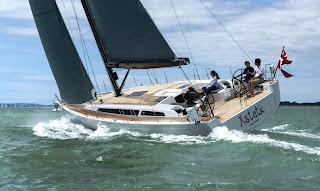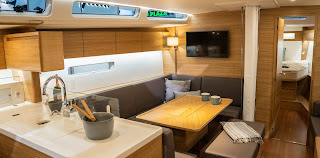I talked about this sailboat when it was at the project stage, back in 2020, and failed to give any more information. It could have seemed that the Virgin Mojito 650 had not passed to the production stage, but that is not the case, and till April this year 6 boats have been launched, probably more at this time.
 |
| The Mojito 650 is the cruising version of the Maxi 650 racer, the boat that won more times the Transat in the Series class. |
https://interestingsailboats.blogspot.com/2020/11/virgin-mojito-650.html
I raised some reservations regarding safety stability because the boat is only certified as a Class C sailboat (inshore use) while there are older Mini racers certified as Class A sailboats. It turns out that the demands have changed and today to be certified as a Class B a boat needs to have at least 1500kg, and the mini-racers displace only about 900kg.
That's the case with the racing mini built by IDB (Maxi 650), the same shipyard that builds the Mojito.
For a 900kg boat to be able to make 55kg of positive force at the point of the mast lying at 90º, a big safety stability is required as well as a big AVS, and if the 900kg of displacement means that the overall stability is not big, the big safety stability means that the dynamic stability is excellent.
Being the Mojito Virgin 650 derived from the racing boat and displacing only 1200kg they chose not to weigh the boat unnecessarily with 300kg more, just to certify it as a Class B sailboat.
 |
Oceanis 30.1 |
Dynamic stability is very important to sailboat safety and is linked with the ability to dissipate the energy of a breaking wave while skidding (instead of converting it in a rolling movement) and the ability to righten itself up very quickly after a knockdown, not allowing the boat to be caught by the next wave still lying or deeply heeled, and without almost no positive stability.
 |
Django 770 |
Why am I talking about these two very different cruising boats? Because the prices of a sailaway boat should not be that different and that counts a lot when choosing a cruising boat.
These boats represent, for a similar cost, opposite perspectives regarding cruising. The Mojito gives top priority to the sailing part of cruising and to sailing as a sport, while the Oceanis gives priority to the living aboard functionality, which is part of cruising in a sailboat.
You can make a virtual visit to the Mojito 650 here:https://www.idbmarine.fr/3D/Visite%20Mojito%20650.html
A racing Maxi 650 doing the Mini Transat:
 |
Oceanis 30.1 interieur |
It offers also bigger seaworthiness, with a Class B standard certification, bigger overall stability (1750 kg displacement) for a not-very-different safety and dynamic stability, having several keel options, including a swing keel with 1.90m draft and 600kg ballast (34.3%B/D).
A Django 770 doing a circumnavigation:https://interestingsailboats.blogspot.com/2020/04/a-never-ending-circumnavigation-on-25ft.html
But if you want to cruise, sailing in a boat with an almost racing performance, with about the same sensations, the Mojito Virgin 650 offers the cheapest way to do it. It all depends on how important sailing pleasure is for you in comparison to living comfort.
 |
| On top Django 770, Directly above, Virgin Mojito 650 |
A radical sailboat for radical cruisers and sometimes being radical about something is not a bad thing and makes us enjoy life with undiluted pleasure.
Today I am old and that affects my perspective but I remember all the joy I had cruising each year for a month in a boat about the size of that one, equally devoid of any interior, with a much smaller interior volume and much less standing height. There is a remarkable pleasure in living simply, keeping only the important things in mind, and for me, sailing and traveling, are the most important parts of cruising, and I love having fun while sailing.




.jpg)




.jpg)
.jpg)



.jpg)





.jpg)



.jpg)






